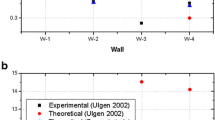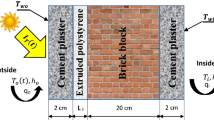Abstract
In the present study, the insulation mechanism of building walls during the summer days and nights is investigated with a realistic approach to enhance their performance. A fiber layer, as a porous medium with air gaps, is used along the wall layers to decrease the energy loss. Meanwhile, the radiation heat flux variation during five days in a row has been considered for each side of the building, and it is tried to reach the optimum values for geometrical factors and find suitable insulation for each side of the building. A lattice Boltzmann method (LBM) based code is developed to simulate the actual chain of the heat transfer which consists of radiation, conduction, forced and natural convection combination within wall layers including fiber porous insulation. The results indicate that for the current insulation model, the effect of natural convection on the heat transfer is not negligible and the existence of the porous layer has caused a positive impact on the heat loss reduction by decreasing the circulation speed. Also, by using the optimum location and thickness for the insulation layer, it is showed that each side of the building has different rates of energy loss during a day, and for the appropriate insulation, they need to be evaluated separately.
摘要
对建筑墙体在夏季日夜的隔热机理进行了研究, 并提出了一种切实可行的方法来提高其性能。 沿壁层使用一种具有多孔结构的纤维层以减少能量损失。同时监测建筑各面连续5 d 的辐射热流变化, 以找到最佳的结构和合适的隔热层。建立了基于格子玻尔兹曼方法(LBM)的数值模拟程序, 模拟了含 纤维多孔保温材料的壁面内辐射、传导、强制对流和自然对流组合的实际传热链。结果表明:对于目 前的绝热模型, 自然对流在传热中的作用不可忽略, 多孔层的可降低循环速度和热损失。此外, 建筑 的各面在一天中的能量损失率也不同, 需要分别进行评估以确定合适的保温层。
Similar content being viewed by others
Abbreviations
- c :
-
Lattice speed
- c s :
-
Sound speed
- c p :
-
Specific heat at constant pressure
- Da :
-
Darcy number
- F :
-
Body forces
- f :
-
Particle distribution function
- f eq :
-
Equilibrium particle distribution function
- g :
-
Energy distribution function
- g eq :
-
Equilibrium energy distribution function
- h :
-
Convective heat transfer coefficient
- H :
-
Characteristic length in the y-direction
- k :
-
Thermal conductivity
- K :
-
Permeability
- L :
-
Characteristic length in x-direction
- M :
-
Transform matrix
- Nu :
-
Average Nusselt number
- \(\overline {Nu} \) :
-
Local Nusselt number
- P :
-
Pressure
- Pr :
-
Prandtl number
- Gr :
-
Grashof number
- T :
-
Temperature
- U :
-
X-direction velocity
- V :
-
Y-direction velocity
- X, Y :
-
Cartesian coordinates
- α :
-
Thermal diffusivity
- β :
-
Thermal expansion coefficient
- μ :
-
Dynamic viscosity
- ν :
-
Kinematic viscosity
- ρ :
-
Density
- ω :
-
Weighting factor
- ε :
-
Porosity
- c:
-
Convection
- e:
-
Emissivity
- f:
-
Fluid-phase
- α :
-
Lattice direction
- s:
-
Solid-phase
- env:
-
Environment
- amb:
-
Ambient
- i:
-
Indoor
- o:
-
Outdoor
References
YANG Hua, CHEN Wan-he, KONG Xiang-fei, RONG Xian. Fabrication, property characterization and thermal performance of composite phase change material plates based on tetradecanol-myristic acid binary eutectic mixture/expanded perlite and expanded vermiculite for building application [J]. Journal of Central South University, 2019, 26(9): 2578–2595. DOI: https://doi.org/10.1007/s11771-019-4196-2.
LEE M J, LEE K G, SEO W D. Analyses on performances of heat and multilayer reflection insulators [J]. Journal of Central South University, 2012, 19(6): 1645–1656. DOI: https://doi.org/10.1007/s11771-012-1188-x.
NIA M F, NASSAB SAG. Transient numerical simulation of annealing process in a conjugate combined radiation conduction heat transfer [J]. Journal of Central South University, 2020, 27(9): 2662–2672. DOI: https://doi.org/10.1007/s11771-020-4489-5.
ALHEFNAWI M A M, ABDU-ALLAH AL-QAHTANY M. Thermal insulation efficiency of unventilated air-gapped facades in hot climate [J]. Arabian Journal for Science and Engineering, 2017, 42(3): 1155–1160. DOI: https://doi.org/10.1007/s13369-016-2370-5.
RASHIDI S, ESFAHANI J A, KARIMI N. Porous materials in building energy technologies—A review of the applications, modelling and experiments [J]. Renewable and Sustainable Energy Reviews, 2018, 91: 229–247. DOI: https://doi.org/10.1016/j.rser.2018.03.092.
WU Xun, SHI Jian-yong, LEI Hao, LI Yu-ping, OKINE L. Analytical solutions of transient heat conduction in multilayered slabs and application to thermal analysis of landfills [J]. Journal of Central South University, 2019, 26(11): 3175–3187. DOI: https://doi.org/10.1007/s11771-019-4244-y.
TAN Zhi-qiang, HOWELL J R. Combined radiation and natural convection in a two-dimensional participating square medium [J]. International Journal of Heat and Mass Transfer, 1991, 34(3): 785–793. DOI: https://doi.org/10.1016/0017-9310(91)90125-X.
BILAL ASHRAF M, HAYAT T, ALSAEDI A, SHEHZAD S A. Convective heat and mass transfer in MHD mixed convection flow of Jeffrey nanofluid over a radially stretching surface with thermal radiation [J]. Journal of Central South University, 2015, 22(3): 1114–1123. DOI: https://doi.org/10.1007/s11771-015-2623-6.
VIVEK V, SHARMA A K, BALAJI C. Interaction effects between laminar natural convection and surface radiation in tilted square and shallow enclosures [J]. International Journal of Thermal Sciences, 2012, 60: 70–84. DOI: https://doi.org/10.1016/j.ijthermalsci.2012.04.021.
MIKHAILENKO S A, MIROSHNICHENKO I V, SHEREMET M A. Thermal radiation and natural convection in a large-scale enclosure heated from below: Building application [J]. Building Simulation, 2021, 14(3): 681–691. DOI: https://doi.org/10.1007/s12273-020-0668-4.
RAMESH N, VENKATESHAN S P. Effect of surface radiation on natural convection in a square enclosure [J]. Journal of Thermophysics and Heat Transfer, 1999, 13(3): 299–301. DOI: https://doi.org/10.2514/2.6458.
MARTYUSHEV S G, SHEREMET M A. Numerical analysis of 3D regimes of natural convection and surface radiation in a differentially heated enclosure [J]. Journal of Engineering Thermophysics, 2015, 24(1): 22–32. DOI: https://doi.org/10.1134/S1810232815010038.
CHOI H K, YOO G J, KIM C H. Characteristics of radiation and convection heat transfer in indirect near-infrared-ray heating chamber [J]. Journal of Central South University, 2011, 18(3): 731–738. DOI: https://doi.org/10.1007/s11771-011-0755-x.
CHEN Hong, OOKA R, KATO S. Study on optimum design method for pleasant outdoor thermal environment using genetic algorithms (GA) and coupled simulation of convection, radiation and conduction [J]. Building and Environment, 2008, 43(1): 18–30. DOI: https://doi.org/10.1016/j.buildenv.2006.11.039.
ARMANDO G M, ARMANDO B B J, CHRISTIAN V C, RANGEL-HERNÁNDEZ V H, BELMAN-FLORES J M. Analysis of the conjugate heat transfer in a multi-layer wall including an air layer [J]. Applied Thermal Engineering, 2010, 30(6, 7): 599–604. DOI: https://doi.org/10.1016/j.applthermaleng.2009.11.004.
MAHLIA T M I, IQBAL A. Cost benefits analysis and emission reductions of optimum thickness and air gaps for selected insulation materials for building walls in Maldives [J]. Energy, 2010, 35(5): 2242–2250. DOI: https://doi.org/10.1016/j.energy.2010.02.011.
OZEL M, PIHTILI K. Optimum location and distribution of insulation layers on building walls with various orientations [J]. Building and Environment, 2007, 42(8): 3051–3059. DOI: https://doi.org/10.1016/j.buildenv.2006.07.025.
MAVROMATIDIS L E, BYKALYUK A, EL MANKIBI M, MICHEL P, SANTAMOURIS M. Numerical estimation of air gaps’ influence on the insulating performance of multilayer thermal insulation [J]. Building and Environment, 2012, 49: 227–237. DOI: https://doi.org/10.1016/j.buildenv.2011.09.029.
POURESLAMI P, SIAVASHI M, MOGHIMI H, HOSSEINI M. Pore-scale convection-conduction heat transfer and fluid flow in open-cell metal foams: A three-dimensional multiple-relaxation time lattice Boltzmann (MRT-LBM) solution [J]. International Communications in Heat and Mass Transfer, 2021, 126: 105465. DOI: https://doi.org/10.1016/j.icheatmasstransfer.2021.105465.
HEYHAT M M, MOUSAVI S, SIAVASHI M. Battery thermal management with thermal energy storage composites of PCM, metal foam, fin and nanoparticle [J]. Journal of Energy Storage, 2020, 28: 101235. DOI: https://doi.org/10.1016/j.est.2020.101235.
AMI AHMADI H, VARIJI N, KAABINEJADIAN A, MOGHIMI M, SIAVASHI M. Optimal design and sensitivity analysis of energy storage for concentrated solar power plants using phase change material by gradient metal foams [J]. Journal of Energy Storage, 2021, 35: 102233. DOI: https://doi.org/10.1016/j.est.2021.102233.
POURRAHMANI H, MOGHIMI M, SIAVASHI M, SHIRBANI M. Sensitivity analysis and performance evaluation of the PEMFC using wave-like porous ribs [J]. Applied Thermal Engineering, 2019, 150: 433–444. DOI: https://doi.org/10.1016/j.applthermaleng.2019.01.010.
JELLE B P. Traditional, state-of-the-art and future thermal building insulation materials and solutions-Properties, requirements and possibilities [J]. Energy and Buildings, 2011, 43(10): 2549–2563. DOI: https://doi.org/10.1016/j.enbuild.2011.05.015.
WALKER R, PAVÍA S. Thermal performance of a selection of insulation materials suitable for historic buildings [J]. Building and Environment, 2015, 94: 155–165. DOI: https://doi.org/10.1016/j.buildenv.2015.07.033.
CAO Xuan, LIU Jun-jie, CAO Xiao-dong, LI Qian, HU E, FAN Feng-hua. Study of the thermal insulation properties of the glass fiber board used for interior building envelope [J]. Energy and Buildings, 2015, 107: 49–58. DOI: https://doi.org/10.1016/j.enbuild.2015.08.007.
ZHENG Wei-xin, XIAO Xue-ying, CHANG Cheng-gong, DONG Jin-mei, WEN Jing, HUANG Qing, ZHOU Yuan, LI Ying. Characterizing properties of magnesium oxychloride cement concrete pavement [J]. Journal of Central South University, 2019, 26(12): 3410–3419. DOI: https://doi.org/10.1007/s11771-019-4263-8.
BEJAN A. Convection heat transfer, [M]. third edition. New Jersey: Wiley, 2004
BRINKMAN H C. A calculation of the viscous force exerted by a flowing fluid on a dense swarm of particles [J]. Flow, Turbulence and Combustion, 1949, 1(1): 27–34. DOI: https://doi.org/10.1007/BF02120313.
SCHEIDEGGER A E. The physics of flow through porous media [M]. 3rd edition. Toronto: University of Toronto Press, 1957. DOI: https://doi.org/10.3138/9781487583750.
SIAVASHI M, GHASEMI K, YOUSOFVAND R, DERAKHSHAN S. Computational analysis of SWCNH nanofluid-based direct absorption solar collector with a metal sheet [J]. Solar Energy, 2018, 170: 252–262. DOI: https://doi.org/10.1016/j.solener.2018.05.020.
PENG Cheng, MIN Hao-da, GUO Zhao-li, WANG Lianping. A hydrodynamically-consistent MRT lattice Boltzmann model on a 2D rectangular grid [J]. Journal of Computational Physics, 2016, 326: 893–912. DOI: https://doi.org/10.1016/j.jcp.2016.09.031.
GHASEMI K, SIAVASHI M. Three-dimensional analysis of magnetohydrodynamic transverse mixed convection of nanofluid inside a lid-driven enclosure using MRT-LBM [J]. International Journal of Mechanical Sciences, 2020, 165: 105199. DOI: https://doi.org/10.1016/j.ijmecsci.2019.105199.
MEZRHAB A, BOUZIDI M, LALLEMAND P. Hybrid lattice-Boltzmann finite-difference simulation of convective flows [J]. Computers & Fluids, 2004, 33(4): 623–641. DOI: https://doi.org/10.1016/j.compfluid.2003.05.001.
JAMAL B, BOUKENDIL M, ABDELBAKI A, ZRIKEM Z. Numerical simulation of coupled heat transfer through double solid walls separated by an air layer [J]. International Journal of Thermal Sciences, 2020, 156: 106461. DOI: https://doi.org/10.1016/j.ijthermalsci.2020.106461.
Author information
Authors and Affiliations
Contributions
CHEN Ya-bin conducted simulations and provided the results, PEI Xing-wang provided the concept and wrote the first draft of paper, HAN Bing-zheng edited the draft ofmanuscript.
Corresponding author
Additional information
Conflict of interest
CHEN Ya-bin, PEI Xing-wang, HAN Bing-zheng declare that they have no conflict of interest.
Rights and permissions
About this article
Cite this article
Chen, Yb., Pei, Xw. & Han, Bz. Thermal performance analysis of building construction with insulated walls in summer days and nights. J. Cent. South Univ. 28, 3613–3625 (2021). https://doi.org/10.1007/s11771-021-4879-3
Received:
Accepted:
Published:
Issue Date:
DOI: https://doi.org/10.1007/s11771-021-4879-3
Key words
- performance enhancement
- building insulation
- radiation/convection/conduction combination
- lattice Boltzmann method (LBM)




